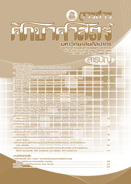อักษรไทยย่อในสมุดไทยเรื่องนันโทปนันทสูตรคำหลวงของเจ้าฟ้าธรรมธิเบศร ไชยเชษฐสุริยวงศ์
Main Article Content
Abstract
บทความวิจัยนี้มีจุดประสงค์เพื่อวิเคราะห์รูปอักษรและอักขรวิธีของอักษรไทยย่อที่ใช้บันทึกในสมุดไทย เรื่องนันโทปนันทสูตรคำหลวงซึ่งนับถึงปัจจุบัน มีอายุ ๒๗๖ ปี ผลการศึกษาพบว่าอักษรไทยย่อเป็นอักษรไทย ชนิดหนึ่ง มีลักษณะหักเหลี่ยมย่อมุมเส้นอักษรให้สวยงาม เป็นแบบอักษรไทยที่เกิดขึ้น นิยมใช้ในสมัยอยุธยา และ เสื่อมความนิยมไปในสมัยอยุธยา อักษรไทยย่อในสมุดไทยเรื่องนี้นับเป็นอักษรไทยย่อที่งดงามที่สุด นอกจากนี้ คำหลวงเล่มนี้ยังพบรูปพยัญชนะและเครื่องหมายที่ยังไม่เคยพบมาก่อนในระบบอักขรวิธีไทย จำนวน ๓ รูป คือ พยัญชนะ ฑ ( ) และ ฮ ( ) ทำให้อักษรไทยมีจำนวนครบ ๔๔ ตัวเป็นครั้งแรก และพบการใช้ เครื่องหมายทัณฑฆาต ( ) เป็นครั้งแรก โดยใช้เขียนกำกับบนพยัญชนะที่เป็นตัวสะกด ส่วนสระพบว่า สระเอาะและสระอัว มีรูปสระแตกต่างไปจากเดิมคือเป็นรูป -อะ ( ) และ -ูว ( ) ตามลำดับ ในด้าน อักขรวิธีนั้น ส่วนใหญ่ไม่แตกต่างกับอักขรวิธีของอักษรไทยแบบธรรมดา
Chaiyachetsuriyawong’s Samut Thai “Nanthopananthasut Khamiuang”
This research aims to analyze of the Thai-yor scripts and their spelling system employed in the 276-year-old Samut Thai “Nanthopananthasut Khamiuang.” The findings showed that the Thai-yor scripts were a type of line letters that were invented, beautified and popularly used only in the Aytthaya period The Thai-yor scripts that had been used in this Khamluang were the ones which were the most perfect and beautiful. In addition, the use of some letters ฑ ( ) and ฮ ( ) and a sign called Thanthakhat ( ) was also found in this Khamluang, resulting in the Thai language having 44 letters in all for the first time. Here the vowels and changed their earlier written forms to become ( ) and ( ), respectively. However, there was little difference at that time in the spelling of compressed and ordinary letters.


